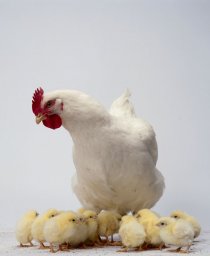

Chicken Infectious Anemia
The Chicken Infectious Anemia virus (CAV) mainly causes disease in chickens.
CAV was first described in Japan in 1979 by Yuasa et al. and appears to be ubiquitous in all major chicken producing countries of the world.
Chickens of all ages can be infected. Susceptibility to disease rapidly decreases after the first 2- 3 weeks of life. Concurrent infections with immunosuppresive agents such as Marek’s Disease virus, Reticuloendotheliosis virus or Infectious Bursal disease virus causes a delay in the development of age resistance and increased morbidity and mortality amongst infected birds.
The significance of CAV
CAV is spread vertically and horizontally in chickens. After infection different organs are affected. Clinical disease is acute with increased mortalities. Although the clinical manifestations are important, immunosuppresion caused by CAV infections results in lower production parameters. Control is best achieved by improved biosecurity and vaccination of breeders.
About this website
Chicken-anemia.com is the first peer reviewed website with a specific focus on Chicken Infectious Anaemia. By building this website Merck Animal Health aims to provide a platform for peer reviewed disease information, current news items and vaccination information.

CAV causes immunosuppression, resulting in lower production parameters.

